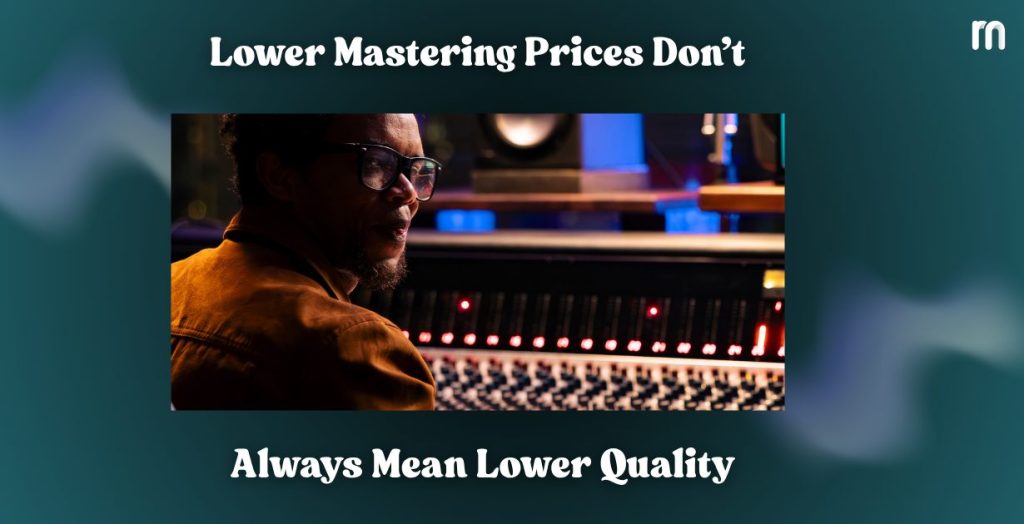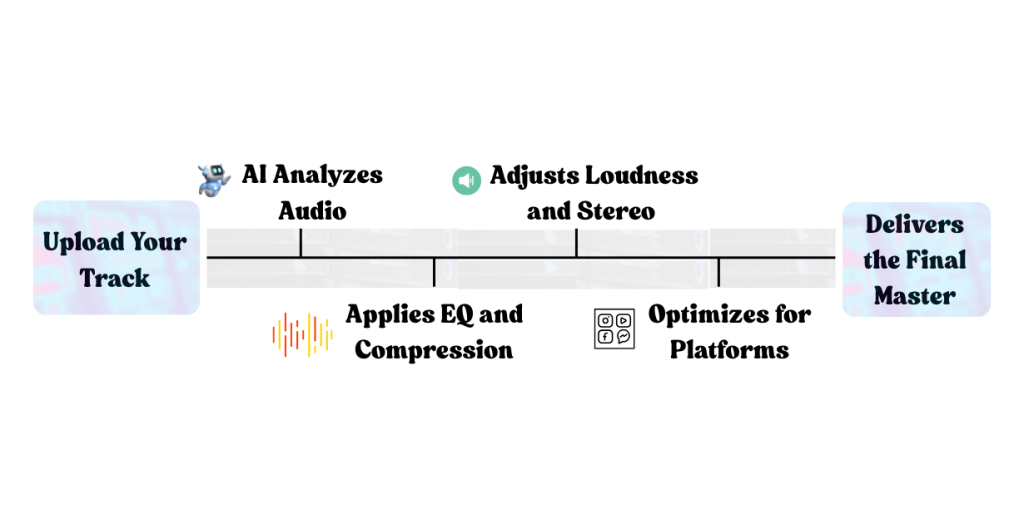Ever heard the phrase, “You get what you pay for?” When it comes to professional song mastering prices, most people assume low prices mean low quality. But what if that’s no longer true?

In today’s world of smart technology and AI-driven tools, mastering prices doesn’t have to be huge. If you’ve been holding off on finishing your track because mastering feels out of reach, this might change everything.
In this blog we will break the myth that affordable online mastering can’t deliver big-league results. You’ll be surprised by what’s possible now.
Table of Contents
Why Mastering Prices Has Historically Been High?
Why Lower Mastering Prices Don’t Always Mean Lower Quality?
The Rise of AI-Powered Mastering Services
Why Mastering Prices Has Historically Been High?
The Legacy Pricing Model: Studio Time, Gear, and Golden Ears

Back in the day, getting your music mastered wasn’t just a creative step—it was a serious financial decision.
You were paying for much more than just a polished final version. You were booking a high-end studio, packed with analog gear worth thousands. Every knob, every cable, every speaker was part of a finely tuned setup built for one thing: perfection.
Then came the mastering engineer. Not just anyone with a laptop—these were seasoned pros with trained ears, deep musical instincts, and often a wall full of credits.
All of that added up. A single master could cost $200, $500, or even more. And honestly? For a long time, that was the only way to do it right.
Sometimes, You’re Paying for the Name—Not Just the Sound
Here’s something most people don’t talk about: mastering prices aren’t always based on sound quality alone. Reputation, too, played a huge role.
Engineers who’ve worked on hit records or won awards often charge top dollar—sometimes $1,000 or more per track. Why? Because their name adds perceived value, even before they touch your audio.
That doesn’t mean their work isn’t great—it usually is. But it also means you could be paying more for their brand than the actual difference in your final sound.
It’s prestige pricing. And it’s not for everyone.
How much does mastering a song cost?
Mastering prices vary widely, but here’s a realistic and short breakdown based on current industry standards:
- Entry-Level Engineers
$20 – $50 per track
Great for demos, indie artists, and budget-conscious creators.
- Mid-Tier Professionals
$100 – $300 per track
Includes experienced engineers using hybrid analog-digital setups.
- High-End Studios
$500 – $1,200+ per track
Often handled by Grammy-winning engineers with full analog chains and name recognition.
These ranges reflect not just the sound quality—but the time, gear, and reputation behind it.
Core Values of Professional Song Mastering Services
Professional song mastering services isn’t only about making your track louder. It’s about making it sound complete. The cost reflects skills, environment, and technical precision, therefore making it expensive.
Ear training and critical listening: Mastering engineers don’t just hear music—they analyse it. Years of experience sharpen their ability to detect even the smallest issues, like harsh frequencies or muddy low-end. Their ears are their most valuable (and hard-earned) tools, and you’re paying for that precision.
Treated acoustic environment: Unlike a bedroom setup, a mastering studio is built for accuracy. The room is tuned to avoid reflections and false readings, while the monitors are calibrated to reveal every sonic detail. That kind of setup isn’t cheap to build or maintain—and it’s a big reason their rates are high.
Objectivity: is another key. After spending hours mixing your own song, your ears can lose perspective. A mastering engineer comes in fresh. They’re not attached to the track. They can immediately identify what needs tightening or softening—without bias.
Guidance on output formats: Whether you’re releasing on Spotify, vinyl, YouTube, or all three, each platform has different technical standards. A pro knows how to prepare your master so it sounds right everywhere and doesn’t get rejected or altered by algorithms.
Option for revisions and alternate versions: Need an instrumental? A radio edit? Clean version? Most mastering engineer offer multiple versions or will make tweaks based on your feedback. It’s part of delivering a complete, polished package.
These are the fundamentals that justify high mastering prices. You’re not just paying for a service—you’re paying for precision and trust.
Why Lower Mastering Prices Don’t Always Mean Lower Quality
Cheap mastering prices doesn’t Always Mean Cheesy
When you see cheap mastering services, your first thought might be, “What’s the catch?”
For a long time, the music world pushed the idea that only expensive studios could attain professional song mastering. And that made sense—back when analog gear, studio rent, and elite engineers were the only path to good sound.
But today? That’s not the whole picture anymore.
Technology has changed the rules. AI mastering platforms, advanced plugins, and smarter workflows now deliver impressive results at a fraction of the old cost. In some cases, you might get a cleaner, more balanced sound from a $15 AI master than a rushed $300 studio job.
Therefore, mastering prices doesn’t always reflect quality—it often reflects overhead. You’re not paying for magic. You’re paying for time, tools, and sometimes, tradition.
The truth? Lower prices can still deliver serious quality. You just have to know what to look for.
High Prices Often Cover Overhead—Not Better Sound
Here’s something most artists don’t realize: a big chunk of traditional mastering prices isn’t just for the final product—it’s the costs behind the scenes.
Think about it. High-end studios have rent, staff, maintenance, and equipment upgrade to cover. That glossy mastering chain with vintage analog gear? It looks great and sounds amazing, but it also adds thousands in upkeep every year.
Engineers working out of those spaces need to price their services high—just to stay in business.
But that doesn’t always mean the end result is miles ahead of something more affordable. In fact, many budget-friendly platforms and independent engineers work lean, using efficient setups or automation to cut costs without cutting quality.
In the end, you might be paying for a name on the invoice—not a difference in what comes out of your speakers.
Even the Skeptics Are Coming Around to AI Mastering
When AI mastering services first showed up, a lot of people in the music world rolled their eyes. And honestly? It made sense.
The early versions felt mechanical. They lacked soul. They couldn’t read the emotion of a track the way a human could. On forums, in studios, and across Reddit threads, the verdict was clear: “It’s fine for demos—but don’t release it.”
But things have changed. Fast.
Modern AI tools have evolved. They now listen more like an engineer, not just a machine. Platforms like Remasterify let artists choose intensity, tweak EQ profiles, and even compare versions—features that used to cost a fortune.
While some still swear by the human touch (and in some cases, rightly so), more and more artists are embracing AI for what it is: fast, affordable, and surprisingly good.
The skepticism hasn’t vanished—but respect is growing. Especially when listeners can’t tell the difference.
The Rise of AI-Powered Mastering Services
What Is AI Mastering?

AI Mastering might sound complex, but the idea is pretty simple.
It uses algorithms trained on thousands of professionally mastered tracks to understand what “great” sounds like. These systems analyse your song—its frequencies, dynamics, stereo width, and loudness—and then apply adjustments based on what would make it sound more balanced, clear, and powerful.
Think of it as a super-fast mastering engineer who’s studied every genre, every vibe, and every trick in the book.
The best part? It all happens in minutes. You upload your track, pick a few settings or preferences, and let the AI do its thing. No back-and-forth emails. No waiting days for revisions. And no guessing if you’re paying too much.
It’s fast, it’s scalable, and for many artists, it’s exactly what they need to get their music release-ready—without breaking the bank.
Learn more about AI-Based Mastering here.
Benefits of AI Mastering Services
AI in audio production isn’t just about cutting mastering prices—it’s about removing the barriers that used to slow artists down.
Speed – What once took hours—or even days—can now be done in minutes. You don’t need to wait for an engineer to finish other projects or send revisions. You upload, tweak a few settings, and get your master almost instantly.
Consistency – AI doesn’t get tired. It doesn’t have off days. It applies the same level of care and precision every single time. Whether you’re mastering one song or twenty, your sound stays tight and polished across the board.
Affordability – One of the biggest benefits is that offers affordable online mastering. What used to cost hundreds per track is now available at a fraction of the price. This gives independent artists, bedroom producers, and even podcasters the chance to compete on a professional level—without draining their budget.
It’s not just about saving money. It’s about levelling the playing field.
From Doubt to Proof—AI Mastering Is Closing the Gap
When online AI-based mastering services first entered the scene, it was met with a wave of doubt—and not without reason. Engineers questioned whether a machine could truly understand musical emotion, genre nuances, or the subtle decisions that come from years of experience.
Many in the industry saw AI as a shortcut. A tool for rough demos, not finished releases. But fast forward to today, and the results speak louder than the skepticism.
Even tech publications are paying attention. In a 2024 article on Ars Technica, writer Benj Edwards looks at how AI mastering tools are moving from simple experiments to serious studio options—and whether one click can really handle such a key step in music production. Read the full article here.
Modern AI mastering platforms have grown smarter. They adapt to different styles, offer customizable settings, and produce output that’s clean, loud, and competitive. Some platforms even allow for fine-tuned control over EQ, intensity, and stereo width—tools once reserved for human engineers alone.
While AI still might not replace a seasoned ear in all situations, it’s no longer a “cheap hack.” It’s a serious tool delivering pro-level results—especially for artists who care about sound but don’t have $300 to spend per track.
Skepticism hasn’t vanished—but for many, it’s been replaced by curiosity—and even trust.
Modern AI is now more than just automation

When people hear “AI mastering,” they often picture a one-click tool that spits out a generic track with no soul. But modern platforms are far more than that—they’ve evolved into creative companions.
Take Remasterify, for example. It doesn’t just master your track in seconds—it lets you shape it according to your creative intent.
You can adjust the intensity, fine-tune EQ preferences, widen or tighten the stereo image, and even test different versions before choosing what feels right. It’s fast, yes—but also flexible. That balance of automation and control is what makes today’s AI tools so powerful.
They don’t replace the human touch—they give creators more of it, on their own terms.
Summing Up
For years, professional song mastering was seen as a luxury—something only big-budget artists could afford. But that story is changing. Today’s AI-powered tools like Remasterify offer fast, high quality and affordable online mastering services.
It’s no longer about how much you spend—it’s about how your music sounds. You don’t have to sacrifice quality to stay on budget.
So if you’ve been holding back because mastering seemed out of reach, now’s the time to take the leap. Try it. Listen for yourself.
Because the best sound isn’t always the most expensive—it’s the one that feels right.
